How to build Small & Mid Power RF Attenuators & RF Loads.
Attenuators
RF attenuators are very usefull devises in order to protect VNA’s Spectrum Analyzes, Bench Wattmeters & Frequency Meters
For each purpose we can use attenuators to decrease the output Power of a DUT from the physical level to a lower one which can be measured
with safety without causing damage to our sensitive Laboratory measurement equipement. Mid & High Power Attenuator usally made of a High Power Thin Film Resistor which contains Tantalum Nitride & the dangerous BeO for low thermal contact resistance. Usally it’s a Pi or T Network printed on the material as a solid state device with input & output terminals.
The common RF Attenuator has the same input output Z which is 50 Ohm. For special designs the manufactures can produce different custom Z inputs/outputs.
It could be used as a Dummy Load too but you need to connect a 50ohm Resistor Load terminator with suitable power ratings to the output terminal of the attenuator.
Calculate an attenuator to fit your needs.
You need to know the following parametres
1. Maximum Power Rated & Cooling.
What is the maximum Rated Power for measurement?
Never use a 50W attenuator f.e. to measure a 50W DUT (Device Under Test), you need a bigger attenuator to avoid possible damage the attenuator or your device or both.
You have to avoid two critical mistakes if you are using a 50w attenuator for a DUT with 50W output, you can damage the attenuator & burn the resistor,
or maybe the attenuator can be shorted or decrease the resistance between the input – output & it will destroy the DUT or the Instrument or both of them!
As about the max power for an attenuator in practice you cannot reach the max power level about 100% without a great risk.
First you have to take a look at manufacture’s datasheet, you can see into the session Safe Operation Area the maximum working temperature typically (100C) for 100% Power Use.
That means a very well calculated heatsink with blister copper plate build in or extra added with possible extra cooling fan & very special Thermal Paste with Low Thermal Resistance <0.010C-in²/W must be used.
Most Solid State Chip Attenuator Series have a various range of attenuation for every use starting from 1db to 40db, with common range 1,2,3,4,5,8,10,12,15,20,25,30,35,40db.
You can easily find power chips starting from 0.5W to 1KW.
If you need more attenuation than 40db you can use in series attenuators to reach the desired level.
F.e if you like an attenuation 44db you can use in series a 40db + 4db attenuator.
I suggest you to void a 30db + 10db + 1db + 3db in series network which can decrease the measurement accuracy & it can increase the measurement error too.
Each attenuator has RF connectors for IN/OUT terminals, each connector can add an attenuation (loss) to the total network value which is really unwanted.
You can easily calculate this f.e. at the normalize proceedure on the instrument & you can remove it from the final measurements but it’s always an additional unwanted task to do.
The best way to choose an attenuator is to find your measurement’s device max power input limit, the best way is to read manufacture’s specifications.
always the manufacture noticed the maximum input level & believe me you don’t need to reach or exceed it.
F.e. the Rigol DSA815 needs max +20dbm Input signal more can serious damage the analyzer, that means maximum input power 100mw.
Well you don’t need to reach this level to learn if it’s safe or not, usally the maximum level is more than the recommended but you don’t want to proof it.
3. Frequency Range.
what is the frequency range of the DUT you need to measure, or what range you need to cover for future use?
Most of these attenuators can cover measurement from DC to 20Ghz or more, it depens from the power, manufacture & price of course!
4. Mobility, you need it for your lab or for field measurements?
That means you have to compromise between the weight & the size for a wanted attenuator.
Small power is not a problem you can built it too small & you can install it directly at the instrument output,
Medium power you have to built it seperate & you need to install it between devices with cables.
High Power it’s a really heavy attenuator not easy to carry without a carrying case with wheels or a strong guy to carry the equipment for you!
When I was started to built the following attenuators it was about a very importand project for Geophysical analalysis.
Low Power Attenuators.
There are several serious manufactures they build high quality & presicion attenuators for low power input.
My favorite is MiniCiruits & specially the PAT Series Attenuators PAT-10+, PAT-20+, PAT-30+ etc.
A chip resistor attenuator with low power ratings 1W with frequecncy range DC to 7Ghz.
You can easily build a special PCB f.e. Rogers & you can install it into two BNC or SMA Male Female Connectors.
Here are a few fotos with the construction procedure & the measurements for these goodies.

Full Assembled Attenuators 10, 20 , 30DB

PCB Assembled With BNC Main Bodies
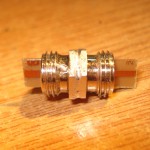
BNC Back Nuts & PCB Installed

PAT-XX+ Factory Package

Dissasembled BNC Male/Female

Spectrum Analysis For A 10 DB Attenuator
You can Dowload The PCB Here PAT-XX+ 23.6mm7.4mm
Medium Power Attenuators
If you decide to build a Medium Power Attenuator you need to calculate the cooling part (heatsink).
Also you need to buy a high grade recommended thermal paste for this.
I’m using a very special paste which is an experimental lab product not easy to produce & find to the market
with Thermal impedance (Resistance) 0.009 C-Sq-In/W
but i suggest you to use the PK-3 Paste by www.proclimatech.com which it’s suitable with the following specifications:
Specific Gravity 2.7gr/sq-cm
Adhesiveness 330000 Cps
Thermal Conductivity 11.2 W/m-C
Thermal impedance (Resistance) 0.013 C-Sq-In/W

http://www.prolimatech.com/en/products/detail.asp?id=1582
For this project i decide to use a 100W attenuator Flange Resistor By AVX Type RP10975A30DBFPBK 30DB Attenuation (attenuator’s for max input 100W the output is about 100mw) With frequency range from DC to 3gHz.
Also an enclosure metal Box GAINTA BS35 to fit the connectors & to keep the resistor safe from dust, moisture & unwanted electromagnetic propagation.
An excellent heatsink from an old HP Desktop PC with copper base were used (Heatsink Type HP P/N:409302-001) which can handle without air cooling 100W
but it’s not recommended, it’s necessary to install a fan on the heatsink for 24/24h use.
Connectors N-TYPE For the input & BNC or SMA for the output, here I’m using BNC without problems.
Here are a few photos with the construction procedure & the measurements for these goodies.

GUIDA BOX BS35 With Installed Connectors

GUIDA BOX BS35 BNC Overview
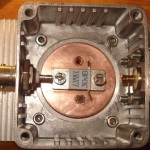
Chip Attenuator Into The Box & Heatsink Included
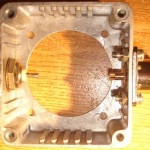
GUIDA BOX BS35 Drilled To Fit Onto Heatsink

HP P/N:409302-001 Heatsink Front View

HP P/N:409302-001 Heatsink Right View

HP P/N:409302-001 Heatsink Bottom View

Attenuator Full Assembled

Spectrum Analysis For A 30 DB Attenuator Which Is Finally 28DBBut It’s OK!
Here is a medium power 30db Flange attenuator 500W By RFLabs build in a GAINTA BS35 box too but with a large heatsink with extra cooper plate 10mm installed on the Al.
The project also contains a 50Ohm Dummy Load 800W power ratings from DC to 1.5Ghz.
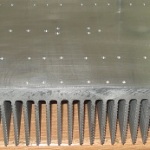
Heatsink KL288 400mm * 200mm

Cooper Plate 400*200*10mm

RFLABS 500W Attenuator at the left side & LOAD Resistor 800W At The Centre.

Full Assembled Sealed Into The Boxes Under Test
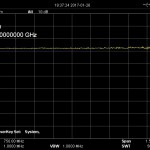
Attenutor 500W Spectrum Analysis
Regards
AkisT
Power Supply & Automation Board For Ceramic Power Tetrodes
This article describes a modern stabilized screen-grid power supply
with MCU that provides adjustable voltage and a good regulation.
It also includes very effective circuits to protect the tube and
the rest of the amplifier.
With some changes to meet specific requirements for screen – grid voltage and current,
they can be used as an upgrade for almost any existing tetrode Power Amplifier.
This project protect the tube and amplifier against faults.
It has been tested in sevarals power amplifiers including
ceramic tetroders 4X150 & 4CX250 4CX1500 mid power amplifiers.
Variable Screen power supply Mosfet based with a standard range
between 200 to 500Vdc & current at least 80-200Ma
which can be limited from 30-200mA VDR Protection included.
Variable Grid power supply with a standard range
from 1.5-140Vdc & current over 200mA VDR Protection included.
Filaments Auto range selector between 6V & 26.5V with current sensor.
SWR Protection for Reflective Power Protection.
Over voltage or zero voltage Protection for both Screen & Grid, (High Voltage Cut Off Mode)
Buzzer for acoustic multiple warnings different for each failure.
Optical fault indicators.
Reset Button.
Service Mode Function for repair, calibration & final test.
Fully isolated MCU Circuit from any other tube voltage.
Low Profile Modular PCB with dimensions 249 x 80 x 35mm or 9.80 x 3.15 x 1.38inch

Protype PCB Automation

The Automation Inside A Medium Power 50-150Mhz 4X150/4CX250/4CX350/8930 Based VHF Amplifier
This project is for sale, available for manufactures only.
Schematics, Gerbers And BOM List Are Available
This project is for sale, available for manufactures only.
Regards
AkisT – George Kentar

A non common but usefull tool for every laboratory is an adjustable power supply, high quality & stability were approved.
When i decided to design this device i was very lucky, a friend of mine came with a damaged one & he ask me to fix it, i took the risk to re engineer it
but as i wrote several times before i’m going to be a whole-hog nerd when i’m going to sign a device, my first thought is always safety & a good MTBF.
A RACK MOUNT 19” 300W PSU 0-30V/0-10A designed (case, pcbs, & panels) for laboratory use, but with a high difficulty constructive level.
Designed for hard working conditions, with over temperature, current & power failure protections.
Specifications
Voltage Supply: 110V-220V 50-60Hz (depend on country region)
Output Voltage: 0-30V DC With step less than 0.1V (full range scale)
Output Current: 0-10A DC
Protection
– Current limitation
– Over temperature protection at 70C
– Short Circuit Protection
– Soft Start Input protection circuit.
Indicators
– Over Temperature with LED
– Fuse failure Indicator with LED
– Over current limitation with LED
Power Consuption 300W max
Ripple Max: 0.2mVrms
THIS PROJECT IS NOT FOR SALE.
Regards
AkisT
 For several times in the past i push myself to work with a medium power lab psu with voltage & current range over 50V & 10Amps.
For several times in the past i push myself to work with a medium power lab psu with voltage & current range over 50V & 10Amps.
I must be honest with my self it was a boring proccess…let me to explain what i mean,
sometimes i fell like a whole-hog nerd & when i’m trying to design or to improve an old design this can transform me to a workalcoholic strange guy.
Yes, i spend over a month into my lab to design a solid state device with excellent performance & stability.
A RACK MOUNT 19” 500W PSU 0-50V/0-10A designed (case, pcbs, & panels) for laboratory use, but with a high difficulty constructive level.
Designed for hard working conditions, with over temperature, current & power failure protections.
Specifications
Voltage Supply: 110V-220V 50-60Hz (depend on country region)
Output Voltage: 0-50V DC With step less than 0.1V (full range scale)
Output Current: 0-10A DC
Protection
– Current limitation
– Over temperature protection at 70C
– Short Circuit Protection
– Soft Start Input protection circuit.
Indicators
– Over Temperature with LED
– Fuse failure Indicator with LED
– Over current limitation with LED
Power Consuption 500W max
Ripple Max: 1mVrms
Schematics, Gerbers And BOM List Are Available
This project is for sale, available for manufactures only.
For technical – hardware and purchase inquiries contact at : akis@crisistech.com
This psu is special recommended for radio amateur use, it’s a simple powerful solid state power supply for linear modules up to 30V/20A DC stabilized with voltage adjustment from 20V to 30V dc.
The basic part is the popular LM317 which has the role to adjust the output voltage, it’s really the perfect component to supply RF linear units where high frequency & RFI is present, the LM317 can give a 1.5 Amp max output so the current amplification stage is necessary, it seems like a monster & it uses 5 x transistors 100V/25A 40A peak current with Ib 5 max Amps , each of them is responsible to supply 5 Amps output current with total current (5 x 5A) = 25 Amps but who wants to push to the limits?
The circuit use 50000Uf input filter & is the best choice for a low ripple output, the pcb is FR4 epoxy with dimensions 16cm x 10cm & a metal aluminum rail installed with 7 screws directly on the pcb, the semiconductors were installed at the bottom side of the pcb to keep them pressed for sure on the heat sink in order to avoid the screwing process for each semiconductor, a square piece of pcb was removed for the bridge to be placed, all the above can give better stability & thermal induction.
This design is flexible & allows you to use less than 5 transistors in case you want to use it for smaller voltage or current output needs from 1.5 to 20Amps.
There are forwarding protection diodes & an output fuse 20 Amps holder for minimum protection, so please don’t forget to include them.
To decrease possible RFI problems small value ceramic capacitors were placed to the output area & I suggest you include the necessary well-calculated RFC choke to the linear input or directly on the psu output (+).
Warning: This psu was designed for indoor & solid state use there is no short circuit protection so it’s not recommend to use it like a variable voltage lab power supply.
It’s an old reliable design with a perfect MTBF, I made a lot of them 20 years ago & they are still working without problems.
Specifications.
Input: 30VAC/25A max (See text)
Output: 20-30VDC 1.5A-20A (see text)
Power Cosumption: 600W max
Ripple: Dimensions: 16cm x 10cm (Included bridge)
This project is for sale, available for manufactures only.
I hope you enjoy the pleasure of construction.
Thank you.


Sometimes you need to check a remote control but you have no time or instruments to check it.
The most common failures are damaged buttons or a dead crystal oscillator.
These remote devices are very sensitive, f.e. common human habits such as drinks and food are not healthy for buttons or
an accidental short flight on the floor is not a good idea either..lol.
There are several ways to test a remote control but if you need a cheap & easy probe i have a solution for you.
BPW41N is a high speed and high sensitive PIN photodiode in a flat side view plastic package.
The epoxy package itself is an IR filter, spectrally matched to GaAs or GaAs on GaAlAs IR emitters
(Lp = 950 nm).
The large active area combined with a flat case gives a high sensitivity at a wide viewing angle.
In this project we need the top of the photodiode as the sensor area so you must leave it uncovered.
At this point we can work with the output signal of this photodiode which is quite enough to see
with an oscilloscope if your remote control works!!!
You can find the specifications for BPW41N at http://www.vishay.com/docs/81522/bpw41n.pdf
You need only 3 elements to make the remote tester & an oscilloscope to have a function view.
1. A good quality Male Metallic Rca
2. A Bnc Male to RCA Female adapter.
3. A BPW41N Photodiode.
Also you must use
A soldering gun less than 40W,
Soldering wire about 0.5” or 12mm,
A small cutter,
A small piece of cable (the cover) to use it as an isolator for the cathode of the photodiode.
You can solder the cathode to the main pin of the RCA & the anode on the ground body (coaxial), look at the picture.
Use the isolator included in the rca to isolate all the photodiode from the main ground,
plug the RCA to the BNC Adapter & put it to the oscilloscope input.
Turn on the Oscilloscope & place a good working remote control at 1-3 inches from the uncovered photodiode top.
Press any button and if your oscilloscope is a modern one use the auto range for the vertical & horizontal functions
at this point you can see a small signal for a few seconds when you press the button, this probably means that
your remote control works at least the button you pressed before, follow the procedure with other buttons.
Next step is to check a faulty remote control.
I wish you happy constructions.
Thank you.

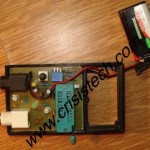
The basic idea came a few months ago when i was trying to find a Xtal for a project but i had over 250 uncategorized pcs. You must test them, i said to myself,…yes you are a recycle fan but you have a lot of garbage in your drawer…
I spent a week to gather info & specs, i have 2 frequency meters & oscilloscopes in my lab, i didn’t want to make a complex device with displays, leds & switches,so finally i made a Xtal & Crystal Oscillator Tester as a plugin device (probe) for my frequency meter or for the oscilloscope.
No more alligators, soldering, testing circuits on breadboards, that’s it!!!
You can use it as RF Oscillator – Generator for your projects too.
You can easily test XTALs & VCXO Crystal Oscs using your lab instruments such as Frequency Meters,
Oscilloscopes & Spectrum Analyzers.
You can watch a short presendation, just click on this youtube link http://youtu.be/WkruzjNsZrs

An Assembled PCB Now It’s Available, For More Details Please Contact, akis at crisistech dot com.
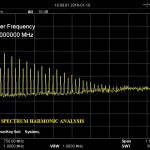
Full Spectrum Harmonic Analysis
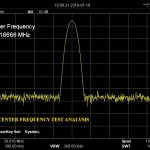
Center Frequency Test Analysis

VCXO Crystal Oscillator Under Test

Optional Outputs
BNC Female 2 Output Plugs Option A (DEFAULT)
SMA Female Jack Option B
SMA Female Jack Option C
SMA Male Jack Option D
SMA Male Jack Option E
Specifications
Xtal tester 1Mhz up to 50Mhz.
Crystal Oscillator Tester as far as it goes…(up to 250Mhz tested).
Dual Output BNC (Default) for frequency meter or oscilloscope.
Xtal Indicator Led for testing without external meters.
Power on switch & led.
A 9 V battery used as Power Supply.
5, 3.3, 2.5V Dip Switch for Different Crystall Oscillators.
Download Manual
Available In Greek
http://www.crisistech.com/blog/wp-content/uploads/2017/11/XtalGreek.pdf
Thank you.





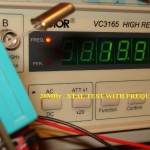



Recent Comments